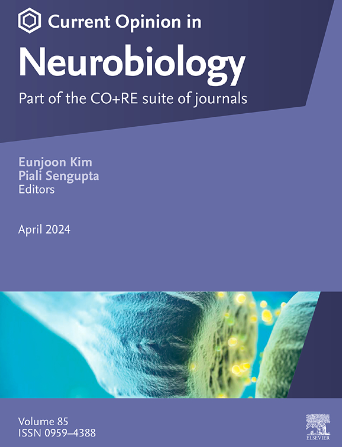活动依赖剪接:大脑中蛋白质组重塑的游戏规则改变者
IF 5.2
2区 医学
Q1 NEUROSCIENCES
引用次数: 0
摘要
大脑错综复杂的神经回路在人的一生中不断受到外部和内部刺激的完善。这些可塑性事件依赖于主要的蛋白质组重塑。活性依赖剪接在指导蛋白质组重塑方面具有无与伦比的潜力,可以实现精确的空间和时间控制。本文回顾了最近在理解活动依赖性剪接方面的进展,并强调了其在大脑可塑性中的作用的未来研究的有希望的领域。本文章由计算机程序翻译,如有差异,请以英文原文为准。
Activity-dependent splicing: A game changer for proteome remodeling in the brain
The brain’s intricate neuronal circuits are continuously refined by external and internal stimuli throughout life. These plasticity events rely on a major proteome remodeling. Activity-dependent splicing has an unparalleled potential to instruct this proteome remodeling, enabling precise spatial and temporal control. This review examines recent progress in understanding activity-dependent splicing and highlights promising areas for future research into its role in brain plasticity.
求助全文
通过发布文献求助,成功后即可免费获取论文全文。
去求助
来源期刊

Current Opinion in Neurobiology
医学-神经科学
CiteScore
11.10
自引率
1.80%
发文量
130
审稿时长
4-8 weeks
期刊介绍:
Current Opinion in Neurobiology publishes short annotated reviews by leading experts on recent developments in the field of neurobiology. These experts write short reviews describing recent discoveries in this field (in the past 2-5 years), as well as highlighting select individual papers of particular significance.
The journal is thus an important resource allowing researchers and educators to quickly gain an overview and rich understanding of complex and current issues in the field of Neurobiology. The journal takes a unique and valuable approach in focusing each special issue around a topic of scientific and/or societal interest, and then bringing together leading international experts studying that topic, embracing diverse methodologies and perspectives.
Journal Content: The journal consists of 6 issues per year, covering 8 recurring topics every other year in the following categories:
-Neurobiology of Disease-
Neurobiology of Behavior-
Cellular Neuroscience-
Systems Neuroscience-
Developmental Neuroscience-
Neurobiology of Learning and Plasticity-
Molecular Neuroscience-
Computational Neuroscience
 求助内容:
求助内容: 应助结果提醒方式:
应助结果提醒方式:


